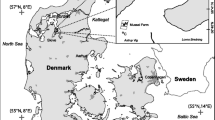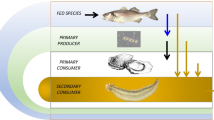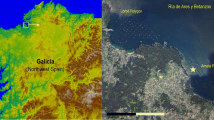Abstract
A current practice of marine aquaculture is to integrate fish with low-trophic-level organisms (e.g. molluscs and/or algae) during farming to minimise effects of cultivation on the surrounding environment and to potentially increase economic income. This hypothesis has been tested in the present article experimentally, by co-cultivating fish and mussels (Mytilus galloprovincialis) in the field. Integrated multi-trophic aquaculture (IMTA) experiments were started in July 2004 by transplanting mussel seed at two depths (−3 and −9 m) within 1,000 m downstream to fish cages and at 1,000 m upstream from cages. Mussels were cultured in nylon net bags for 12 months and the growth recorded biometrically. The outcome of our field experiment corroborated the idea of IMTA effectiveness. In fact, in the study area, the organic matter from fish-farm biodeposition caused changes in the chemical environment (i.e. controls and impacted sites were significantly different for organic matter availability and chlorophyll-a) and this induced changes in growth performance of co-cultivated mussels. Mussels cultivated close to cages, under direct organic emission, reached a higher total length, weight and biomass than mussel cultivated far from farms.




Similar content being viewed by others
References
Cheshuk, B. W., G. J. Purser & R. Quintana, 2003. Integrated open-water mussel (Mytilus planulatus) and Atlantic salmon (Salmo salar) culture in Tasmania, Australia. Aquaculture 218: 357–378.
Dame, R. F., 1996. Ecology of Marine Bivalves: An Ecosystem Approach. CRC Press, Boca Raton, FL, USA.
Gao, Q. F., P. K. S. Shin, G. H. Lin, S. P. Chen & S. G. Cheung, 2006. Stable isotope and fatty acid evidence for uptake of organic waste by green-lipped mussels Perna viridis in a polyculture fish farm system. Marine Ecology Progress Series 317: 273–283.
Gao, Q. F., W. Z. Xu, X. S. Liu, S. G. Cheung & P. K. S. Shin, 2008. Seasonal changes in C, N and P budgets of green-lipped mussels Perna viridis and removal of nutrients from fish farming in Hong Kong. Marine Ecology Progress Series 353: 137–146.
Gould, S. J., 1966. Allometry and size in ontogeny and phylogeny. Biological Review 41: 587–640.
Jones, T. O. & G. K. Iwama, 1991. Polyculture of the Pacific oyster, Crassostrea gigas (Thurnberg) with Chinook salmon, Oncorhynchus tschawytscha. Aquaculture 92: 313–322.
Jones, A. B. & N. P. A. Preston, 1999. Sydney rock oyster, Saccostrea commercialis (Iredale & Roughley), filtration of shrimp farm effluent: the effects on water quality. Aquaculture Research 30: 51–57.
Jones, A. B., M. J. O’Donohue, J. Udy & W. C. Dennison, 2001. Assessing ecological impacts of shrimp and sewage effluent: biological indicators with standard water quality analyses. Estuarine, Coastal and Shelf Science 52: 91–109.
Kalantzi, I. & I. Karakassis, 2006. Benthic impacts of fish farming: meta-analysis of community and geochemical data. Marine Pollution Bulletin 52: 484–493.
Kang, K. H., J. Y. Kwon & Y. M. Kim, 2003. A beneficial coculture: charm abalone Haliotis discus hannai and sea cucumber Stichopus japonicus. Aquaculture 216: 87–93.
Langdon, C. J. & R. I. E. Newell, 1990. Utilization of detritus and bacteria as food sources by two bivalve suspension-feeders, the oyster Crassostrea virginica and the mussel Geukensia demissa. Marine Ecology Progress Series 58: 299–310.
Lefebvre, S., L. Barille & M. Clerc, 2000. Pacific oyster (Crassostrea gigas) feeding responses to a fish-farm effluent. Aquaculture 187: 185–198.
Lin, K. C., P. Raumthaveesub & P. Wanuchsoontorn, 1993. Integrated culture of the green mussel (Perna viridis) in waste water from an intensive shrimp pond: concept and practice. World Aquaculture 24: 68–73.
Lindahl, O., R. Hart, B. Hernroth, S. Kollberg, L. Loo, L. Olrog & A. Rehnstam-Holm, 2005. Improving marine water quality by mussel farming: a profitable solution for Swedish society. Ambio 34: 131–138.
Lucas, A., 1993. Bioénergétique des animaux aquatiques. Masson, Paris.
Mazzola, A. & G. Sarà, 2001. The effect of fish farming organic waste on food availability for bivalve molluscs (Gaeta Gulf, Central Tyrrhenian, MED): stable carbon isotopic analysis. Aquaculture 192: 361–379.
Modica, A., D. Scilipoti, R. La Torre, A. Manganaro & G. Sarà, 2006. The effect of mariculture facilities on biochemical features of suspended organic matter (southern Tyrrhenian, Mediterranean). Estuarine, Coastal and Shelf Science 66: 177–194.
Neori, A., I. Cohen & H. Gordin, 1991. Ulva lactuca biofilters for marine fishpond effluent. II Growth rate, yield and C:N ratio. Botanica Marina 34: 483–489.
Neori, A., T. Chopin, M. Troell, A. H. Buschmann, G. P. Kraemer, C. Halling, M. Shpigel & C. Yarish, 2004. Integrated aquaculture: rationale, evolution and state of the art emphasizing seaweed biofiltration in modern mariculture. Aquaculture 231: 361–391.
Pitta, P., I. Karakassis, M. Tsapakis & S. Zivanovic, 1999. Natural vs mariculture induced variability in nutrients and plankton in the eastern Mediterranean. Hydrobiologia 391: 181–194.
Pitta, P., E. T. Apostolaki, M. Giannoulaki & I. Karakassis, 2005. Mesoscale changes in the water column in response to fish farming zones in three coastal areas in the Eastern Mediterranean Sea. Estuarine, Coastal and Shelf Science 65: 501–512.
Qian, P. Y., C. Y. Wu, M. Wu & Y. K. Xie, 1996. Integrated cultivation of the red alga Kappaphycus alvarezii and the pearl oyster Pinctada martensi. Aquaculture 147: 21–35.
Riera, P. & P. Richard, 1997. Temporal variation of δ13C in particulate organic matter and oyster Crassostrea gigas in Marennes-Oleron Bay (France): effect of freshwater inflow. Marine Ecology Progress Series 147: 105–115.
Sarà, G., 2007a. A meta-analysis on the ecological effects of aquaculture on the water column: dissolved nutrients. Marine Environmental Research 63: 390–408.
Sarà, G., 2007b. The ecological effect of aquaculture on living and not living suspended fractions of the water column: a meta-analysis. Water Research 41: 3187–3200.
Sarà, G., 2007c. The ecological effect of aquaculture on physical variables of the water column: a meta-analysis. Chemistry and Ecology 23: 251–262.
Sarà, G. & A. Mazzola, 1997. Effects of trophic and environmental conditions on the growth of Crassostrea gigas in culture. Aquaculture 153(8): 1–91.
Sarà, G. A., G. Manganaro, A. Cortese, A. Pusceddu & A. Mazzola, 1998. The relationship between food availability and growth in Mytilus galloprovincialis in the open sea (southern Mediterranean). Aquaculture 167: 1–15.
Sarà, G., S. Vizzini & A. Mazzola, 2003. Sources of carbon and dietary habits of new Lessepsian entry Brachidontes pharaonis (Bivalvia, Mytilidae) in the western Mediterranean. Marine Biology 143: 713–722.
Sarà, G., D. Scilipoti, M. Milazzo & A. Modica, 2006. Use of stable isotopes to investigate the dispersion of fish farming waste as a function of hydrodynamics. Marine Ecology Progress Series 313: 261–270.
Sarà, G., M. Lo Martire, G. Buffa, A. M. Mannino & F. Badalamenti, 2007. The fouling community as an indicator of fish farming impact in Mediterranean. Aquaculture Research 38: 66–75.
Shpigel, M., J. Lee, B. Sooho, R. Friedman & H. Gordin, 1993a. The use of outflow water from fish ponds as a food source for Pacific oyster (Crassostrea gigas) Thunberg. Aquaculture and Fish Management 24: 529–543.
Shpigel, M., A. Neori, D. M. Popper & H. Gordin, 1993b. A proposed model for ‘‘environmentally clean’’ land-based culture of fish, bivalves and seaweeds. Aquaculture 117: 115–128.
Stirling, A. & I. Okumus, 1995. Growth and production of mussels (Mytilus edulis L) suspended at salmon cages and shellfish farms in two Scottish sea lochs. Aquaculture 134: 193–210.
Troell, M. & J. Norberg, 1998. Modelling output and retention of suspended solids in an integrated salmon-mussel culture. Ecological Modelling 110: 65–77.
Troell, M., C. Halling, A. Neori, T. Chopin, A. H. Buschmann, N. Kautsky & C. Yarish, 2003. Integrated mariculture: asking the right questions. Aquaculture 226: 69–90.
Underwood, A. J., 1997. Experiments in ecology their logical design and interpretation using analysis of variance. Cambridge University Press, Cambridge.
White, C. R., 2003. Allometric analysis beyond heterogeneous regression slopes: use of the Johnson-Neyman technique in comparative biology. Physiological and Biochemical Zoology 76: 135–140.
Weinberg, S., 1978. The minimal area problem in invertebrate communities of Mediterranean rocky substrata. Marine Biology 49: 33–40.
Acknowledgements
The authors would like to thank Dr. M. Lo Martire, Dr. G. Martino and Dr. A. Oliveri for their kind help in the field, Dr. G. D’Anna (CNR, Italy) for lab facilities, and Mr. F. Cascio and other owners of the “Ittica Trappeto” fish farm (Balestrate, Italy) for their assistance. Thanks also to A. E. Lossmann for fine-tuning the English. This study was supported by Regione Siciliana—Assessorato Cooperazione e Pesca (POR; Misura 4.17, Sottomisura B; n. 1999.IT.16.1.PO.011/4.17b/8.3.7/0053).
Author information
Authors and Affiliations
Corresponding author
Additional information
Handling editor: T. P. Crowe
Rights and permissions
About this article
Cite this article
Sarà, G., Zenone, A. & Tomasello, A. Growth of Mytilus galloprovincialis (mollusca, bivalvia) close to fish farms: a case of integrated multi-trophic aquaculture within the Tyrrhenian Sea. Hydrobiologia 636, 129–136 (2009). https://doi.org/10.1007/s10750-009-9942-2
Received:
Revised:
Accepted:
Published:
Issue Date:
DOI: https://doi.org/10.1007/s10750-009-9942-2




